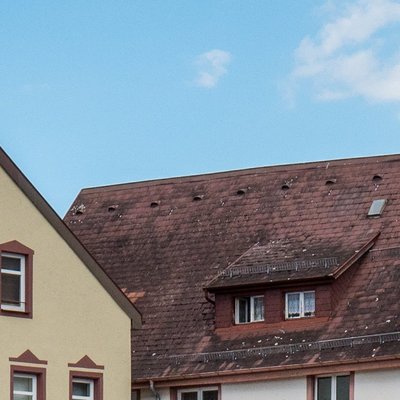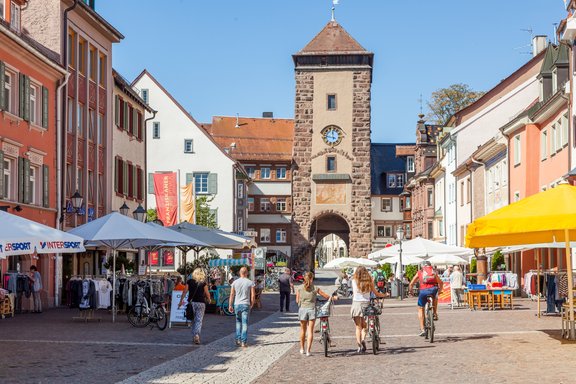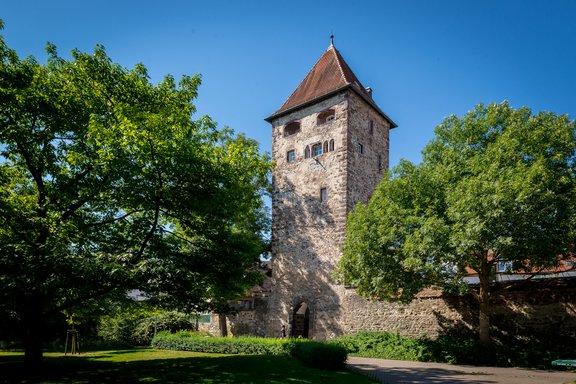
Gates and towers
Gates and towers were an essential and not to be underestimated part of a city defense system. The importance of walls and towers for the protection of a town in those times is shown by the total of four sieges which the district of Villingen had to endure between 1633 and 1704.
City gates

Not accesible to the public
The three city gates from the 13th century look very similar and regularly cause a certain disorientation of our guests. They differ only in the color of their dials: Riettor (blue), Obere Tor (green) and Bickentor (red). Convicts were left to stew in the 'Keffit', the prison in Riettor.
The fourth in the group, the Niederes Tor, fell victim to the need for more space for larger carriages in 1847. The district court and the prison were built of some of the stones.
Riettor
west
the oldest city gate
The construction dates back to 1233. Dendrochronoligical investigations showed that the timber was felled in winter 1232/33. In 1293 the gate was first mentioned in writing. A partial demolition in 1533 is documented. At the Riettor the staircase to the "Keffit" prison is attached.
Oberes Tor
north
The youngest gate with the highest tower
Unfortunately, the start of construction cannot be determined due to sustainable rebuilding work.
The oldest dated part dates from 1493/94.
On the 2nd floor there is a blockhouse used as a detention cell.
Bickentor
east
Was built as one of the first gates
The Bickentor in Villingen was built around the year 1260 and is 18 meters high today. The ground plan of the medieval gate is 8 by 11 meters. The monastery chapel St. Ursula is attached. Since 1480 the monastery has been home to an order of the Poor Clares. In 1782 it became an Ursuline monastery with a school for girls. Until today it is a grammar and secondary school. The monastery continued to exist until summer 2015 when it closed its doors.
The name Bickentor (at the foot of the Bickeberg) goes back to the time before the foundation of the city when Alemanni already settled on the other side of the Brigach. One of them called "Bicko" had his farm on the Bickeberg.
Kaiserturm

The only accessible fortified tower, opening hours by appointment
The 31 m high Kaiserturm was built in 1372. On five floors the visitor is informed about the Villingen's fortifications and sieges. The top floor offers a charming view. Here you can see a slide show in fading technique. The tower was formerly called "Gerberturm" (1692), "Wachtelturm" (1806) and "Schnabelturm" (until about 1870).
When Germany was united for the first time after winning the war against France in 1870/71 and the Prussian King became German Kaiser, many streets and monuments throughout Germany were renamed Kaiserstraße and Kaiser... That is why the tower received its present name in 1871.
In the course of a city tour you can visit it and Slide show and a champagne reception are included for further information about the city tours.
Romäusturm

Not available to the public
with 39 meters the Romäusturm is the highest fortified tower in the city wall. The north side of the tower is decorated with a larger-than-life picture of the local hero Romaeus, who was once imprisoned here and who made himself immortal by breaking out of the dungeon of the former Michael's Tower. The two lower floors were built in 1390. In 1429 the 3rd and 4th upper floors were added.
In terms of defense strategy it had a double meaning. It was possible to defend the area in front of the wall and the gates at the same time as the enemy gun positions on the Hubenloch were being fired at.
in the 13th century a man named Romäus lived in the Zähringer town of Villingen. This man was so tall that he could easily look through the windows of the second floor of the houses. Three peacock feathers on his hat further enhanced the impression of his size.
Romäus worked as a lumberjack in the nearby Black Forest. One day he had loaded his wagon with particularly large tree trunks and the oxen could no longer pull him. So he lifted the oxen onto the wagon and pulled it along with the trees and oxen all by himself to Villingen. So strong was Romäus.
It was above all because of his imposing figure that the people of Villingen chose Romaeus as leader of the vigilante group. In this office he became a national celebrity. In battles with other cities such as Hornberg or Rottweil he emerged victorious in each case.
One of his solo trips to Rottweil is particularly worth mentioning. In the middle of the night he waded through the moat and shortly afterwards he found himself on the market place. The Rottweilers, who had already craved to capture him for a long time, immediately closed their city gates and thought they had caught Romäus now.
But he calmly walked towards one of the town gates, lifted the two wings of the gate off their hinges and disappeared with the gate to Villingen. There they were attached to the Upper Gate, which was just finished at that time.
As his fame grew, so his respect fort he authorities faded. When things got too bad, the city council decided to resort to a ruse to take him prisoner. They gave him the order to get an especially heavy chest from the dungeon of the thief storm. For this he should get a good reward.
So Romäus descended the ladder that led to the dungeon. The moment he lifted the chest, the city servants pulled up the ladder and closed the trapdoor. Thus the strong Romaeus was captured.
Since the giant had rendered the city many good services, however, they did not want to treat him as badly as the other prisoners and threw large portions of the best meat into his cell every day.
From the bones of sheep and calves he built himself a ladder by sticking them into the cracks between the stones. Thus, after several months, he managed to get to the door and break it open. Since he was a bad climber with his huge hands and feet, he pushed the bones into the cracks in the wall to hold on to them even when descending. That's how he escaped from the prison tower on a dark thunderstorm night.
Romäus went directly to the Busenberg Castle, which was in dispute with Villingen. He besieged this castle all alone until it surrendered to him.
Then he went back to Villingen, where he was received friendly again because of this heroic deed and was even paid for his living until his death.
The tower in which Romaeus was imprisoned has been known since then as the Romaeus Tower. Some even claim that this tower was built around the giant Romaeus in order to capture him. In any case, today a huge picture of him is painted on the outside of the tower.
Pulvertürmle

Not available to the public
The tower in front of the Villingen city wall dates from 1499 and was used to store ammunition and gunpowder. On the one hand, the storage was not allowed to endanger the inhabitants of the town, but on the other hand the powder had to be protected from external access. Therefore, the construction of such a powder tower directly on the city wall was an obvious choice. In 1499 a total of four so-called 'powder rondels' were built, of which only one is still preserved today.